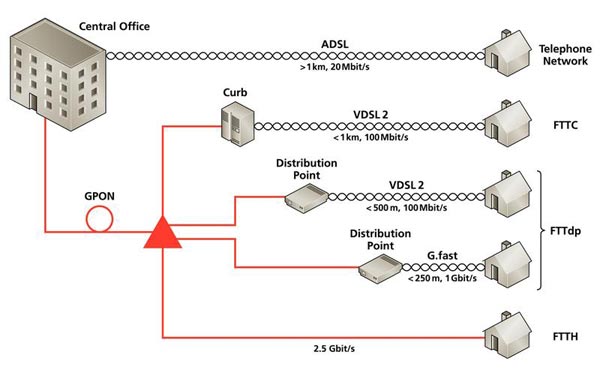Gigabit data rates over copper telephone lines

Fiber-To-The-Distribution Point (FTTdp) – The next evolutionary step on the road from conventional telephone network to full-fledged fiber provisioning
This concept calls for running optical fiber to a distribution point that can be flexibly installed relatively close to the customer premise. The existing copper infrastructure is utilized to complete the access line to and within the building. To determine how 1-2 Gbit/s data rates can actually be achieved in such environments, researchers from Fraunhofer ESK will be working with Lantiq and InnoRoute GmbH until 2016 as part of the FlexDP research project.
Achieving high access data rates requires utilization of the higher frequency ranges on the phone lines. This is possible only if the copper line segment of the data transmission channel is relatively short. With this in mind, Fraunhofer ESK is analyzing the channel properties within these high frequency ranges as part of the FlexDP project. Lantiq and InnoRoute will use the results of this work to eventually develop a reverse powered, flexible distribution point installed closer to the customer premise. Through a combination of research, implementation and testing, the partners are laying the groundwork for the practical application of FTTdp.
Measuring channel properties in the 300 MHz frequency range
VDSL2 utilizes frequencies up to 30 MHz. With the aim of achieving still higher data rates, Fraunhofer ESK is examining the use of frequencies up to 300 MHz. Apart from the transmission characteristics of the line, background noise and sporadic impulse interference are important factors that impact transmission speeds.
Higher frequency ranges permit the deployment of new transmission schemes such as G.fast, which operates up to 212 MHz and is currently in the standardization stage. By extending the currently used spectrum, data rates of up to 2 Gbit/s are theoretically possible, but only if the channel characteristics are consistently taken into consideration.
In order to gain a realistic picture of the situation in Germany, Fraunhofer ESK researchers identified and measured the various types of cables used in the country and examined typical customer premise wiring installations.
Based on this preparatory work and with new measurements in the 300 MHz extended frequency range, engineers will develop a simulation environment allowing them to recreate and test a variety of network scenario. Researchers will then be able to pinpoint early on any issues that affect high bit rate data transmission, thus paving the way for the development of reliable solutions. The know-how gleaned from this work will furthermore flow into future transmission system designs and installations.
Energy-efficient, flexible distribution points accelerate network build-out
Higher data rates with a hybrid network can be reached on short lines. With G.fast, this equates to a maximum of around 250 meters. It also requires locations closer to the customer premise, a task made easier if the distribution points are not dependent on existing power lines and instead are reverse power fed by the customer's telephone lines. That means the shoebox-sized distribution points must be extremely energy-efficient.
The major challenge of this remote power concept lies in the fluctuating loads placed on the network since each customer's behavior is usually different with respect to bandwidth usage and time of day. The hardware architectures and components that will be developed by Lantiq and InnoRoute must be as energy-efficient as possible, just like the transmission method itself, in order to deal with varying customer usage patterns.
That means a single customer modem must provide enough power to operate the distribution point. Transmitter and receiver components also need the capability to dynamically turn on and off, which in turn results in dynamic changes to the crosstalk interference environment. This creates another challenge in developing algorithms for stable transmission in dynamically-changing scenarios. Fraunhofer ESK is furthermore working on emergency operation concepts to compensate for power outages.
This project is being funded by the Bavarian Research Foundation.
For further details contact:
Marion Rathmann | Fraunhofer Institute for Embedded Systems and Communication Technologies ESK | PR & Marketing | phone +49 89 547088-395
Hansastraße 32 | 80686 München | www.esk.fraunhofer.de | marion.rathmann@esk.fraunhofer.de |
Media Contact
All latest news from the category: Information Technology
Here you can find a summary of innovations in the fields of information and data processing and up-to-date developments on IT equipment and hardware.
This area covers topics such as IT services, IT architectures, IT management and telecommunications.
Newest articles

NASA: Mystery of life’s handedness deepens
The mystery of why life uses molecules with specific orientations has deepened with a NASA-funded discovery that RNA — a key molecule thought to have potentially held the instructions for…

What are the effects of historic lithium mining on water quality?
Study reveals low levels of common contaminants but high levels of other elements in waters associated with an abandoned lithium mine. Lithium ore and mining waste from a historic lithium…

Quantum-inspired design boosts efficiency of heat-to-electricity conversion
Rice engineers take unconventional route to improving thermophotovoltaic systems. Researchers at Rice University have found a new way to improve a key element of thermophotovoltaic (TPV) systems, which convert heat…



